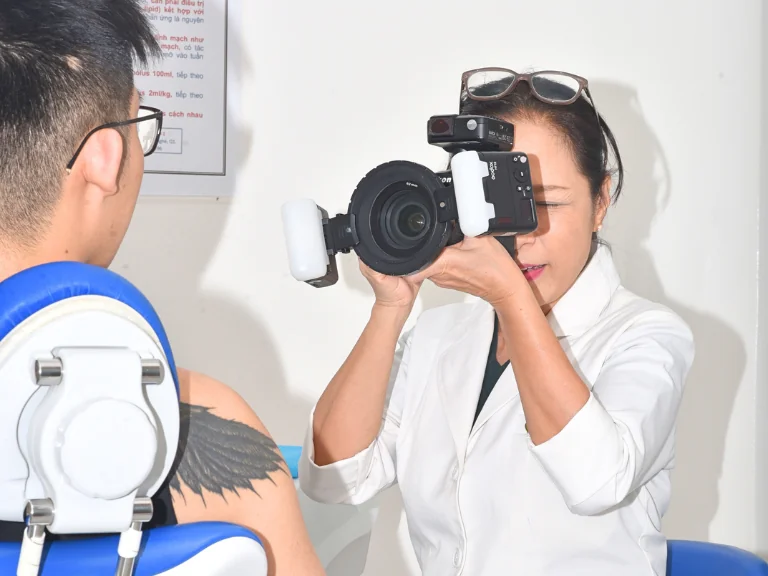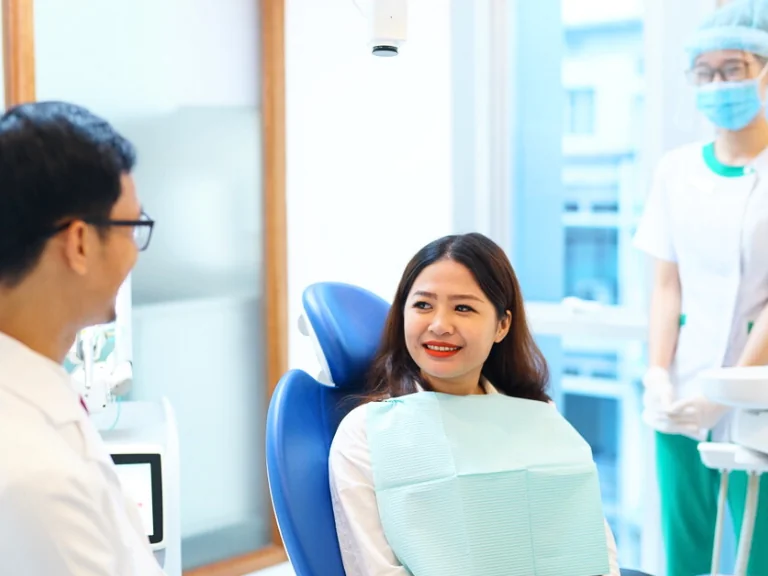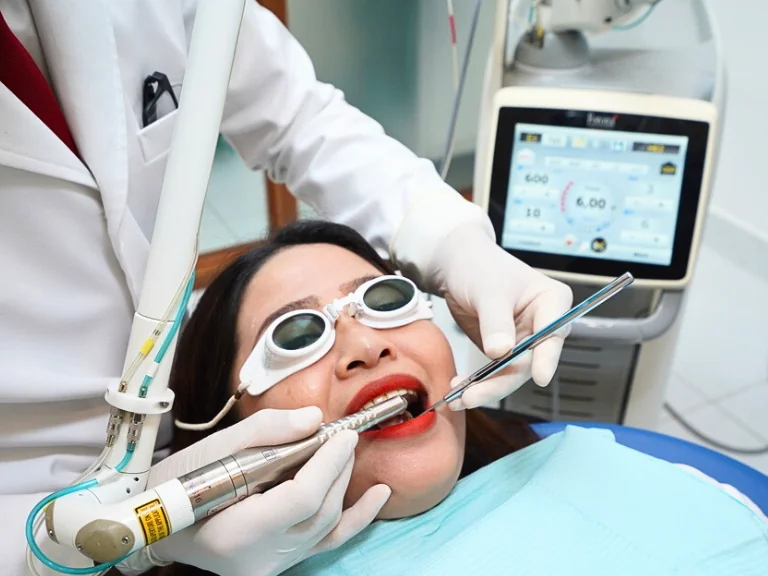In this era of continuous technological advancement, the field of dentistry is constantly innovating to offer optimal treatment methods for patients. One groundbreaking advancement is Laser Dentistry – a dental technology using laser beams, ushering in a new era of oral healthcare with superior precision, reduced pain, and faster recovery times. If you’re looking for a modern, gentle, and effective dental treatment solution, dental laser technology is a top choice.
1. What is Laser Dentistry? Exploring Advanced Technology in Dental Care
Laser Dentistry is an advanced dental treatment method that uses laser beams – a high-energy, focused light beam – to perform various dental procedures. Instead of traditional tools like drills or scalpels, lasers allow dentists to perform procedures with extreme precision, minimizing invasion of surrounding tissues. This not only makes patients more comfortable during treatment but also significantly shortens recovery time.
Laser Dentistry technology is widely used in many areas of dentistry, from simple procedures like teeth whitening to more complex treatments such as gum surgery, root canal therapy, or the removal of benign oral tumors. The versatility and effectiveness of lasers have made dental laser procedures one of the most popular treatment trends today.
Diverse Applications of Laser Dentistry in Oral Treatment
Laser Dentistry isn’t just one technology; it’s a collection of diverse applications addressing various oral health issues. The laser’s versatility allows dentists to effectively treat both soft tissues (gums, cheeks, tongue) and hard tissues (teeth, bone).

2. Treating Gum and Soft Tissue Conditions
Treatment of Gum Disease (Gingivitis, Periodontitis): Laser beams can effectively remove disease-causing bacteria and inflamed tissue deep within periodontal pockets, while stimulating the regeneration of healthy gum tissue. This helps reduce inflammation, bleeding gums, and prevents the progression of periodontal disease.
- Gum Regeneration (Gum Grafting): For cases of receding gums exposing tooth roots, dental lasers support the regeneration of gum tissue, helping to cover the roots, reduce sensitivity, and improve smile aesthetics.
- Crown Lengthening Surgery: To improve the aesthetics of a gummy smile or prepare for dental restorations, lasers can be used to reshape the gum line, making teeth appear longer and more balanced.
- Treatment of Tongue-Tie (Frenectomy): For children or adults who have difficulty speaking due to a short lingual frenum, lasers can remove this tissue quickly, with minimal bleeding and reduced pain.
- Removal of Soft Tissue Folds: Lasers help remove soft tissue folds formed by ill-fitting dentures, providing comfort to patients.
- Biopsy and Removal of Benign Tumors: Laser beams can be used to take biopsies or remove small benign tumors in the oral cavity with precision and minimal invasiveness.
- Treatment of Wisdom Tooth Exposure and Pericoronitis: Lasers help reduce pain, remove bacteria, and inflamed tissue around impacted or infected wisdom teeth.
3. Treating Tooth and Hard Tissue Problems:
- Cavity Treatment: Lasers can precisely remove decayed tooth tissue without traditional drilling, reducing noise and uncomfortable vibrations, making it especially suitable for patients who fear the drill.
- Tooth Preparation for Fillings: Laser beams help remove old enamel and optimally prepare the tooth surface for filling materials, ensuring high adhesion and long-lasting effectiveness.
- Treatment of Tooth Sensitivity: Lasers can seal the tiny dentinal tubules on exposed root surfaces, significantly reducing tooth sensitivity to hot, cold, or acidic stimuli.
- Early Cavity Detection: Some types of lasers can detect tiny cavities that are difficult to see with the naked eye, allowing dentists to intervene promptly and preserve as much natural tooth structure as possible.
- Laser Teeth Whitening: Activates the whitening gel, achieving fast and safe brightening results with less sensitivity compared to traditional methods.

4. Superior Benefits of Laser Dentistry Compared to Traditional Methods
The development of Laser Dentistry has brought significant advantages, creating a more comfortable and effective dental treatment experience for patients:
- Reduced Pain and Minimally Invasive: This is the most outstanding benefit of dental lasers. Lasers work gently on tissues, causing no vibrations or pressure like dental drills, which minimizes pain and discomfort. In many cases, patients may not need anesthesia or only a low dose of local anesthetic.
- Less Bleeding and Swelling: The hemostatic (blood-clotting) ability of lasers helps stop bleeding immediately during soft tissue surgery, reducing bleeding and swelling after treatment. This also keeps the surgical field clean, making it easier for the dentist to operate.
- Faster Recovery Time: With minimal invasiveness and superior bactericidal capabilities, wounds treated with lasers typically heal faster, reducing the risk of complications and infection.
- Enhanced Disinfection Effectiveness: Laser beams can powerfully eliminate bacteria and sterilize the treated area, significantly reducing the risk of post-treatment infections, especially crucial in treating periodontitis and endodontic procedures.
- Preservation of Healthy Tooth Tissue: Thanks to their high precision, lasers only target the specific tissue needing treatment without damaging surrounding healthy tissues, preserving the maximum amount of healthy tooth and gum structure.
- Reduced Anxiety and Fear: For patients who have a fear of the drill or needles, Laser Dentistry offers a gentler solution, helping them feel more comfortable and confident when visiting the dentist.
5. Common Types of Lasers Used in Dentistry
To meet diverse treatment needs, dental laser technology uses various types of lasers, primarily classified based on their interaction with hard or soft tissues:
Hard Tissue Lasers:
Hard Tissue Lasers are primarily used for treating teeth and bone. Their wavelengths are well-suited for interacting with mineral components like calcium phosphate in tooth enamel and dentin.
Key applications of hard tissue lasers include:
- Cavity Removal and Cavity Preparation for Fillings: Lasers can precisely remove decayed tooth areas and prepare the tooth surface for fillings without drilling.
- Treatment of Tooth Sensitivity: By sealing dentinal tubules, hard tissue lasers help reduce sensitivity.
- Early Cavity Detection: Helps identify even the smallest carious lesions.
Soft Tissue Lasers:
Soft Tissue Lasers are specifically designed to interact with water and pigments in soft tissues such as gums, tongue, and oral mucosa. They are ideal for procedures involving gums and other soft tissues in the oral cavity:
- Gum Contouring, Gingivectomy/Gingivoplasty:Reshaping the gum line to improve aesthetics or treat periodontal conditions.
- Crown Lengthening Surgery: Adjusting gum and bone tissue to expose more tooth structure.
- Treatment of Periodontal Disease: Removing bacteria and inflamed tissue in periodontal pockets.
- Removal of Benign Tumors, Biopsies: Performing minor oral surgeries with high precision and less bleeding.
- Frenectomy (Lip-Tie/Tongue-Tie Release): Releasing connective tissue bands that restrict movement.




